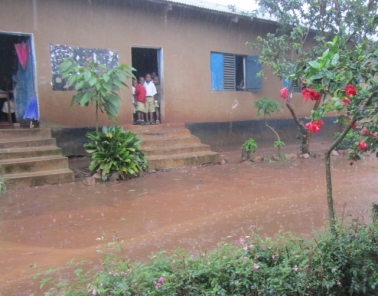 Cuso/VSO have been recruiting people for “placements” in the areas of Education, Health, HIV/AIDS, Secure livelihoods and Governance for the past 50 years. From now until 2016 they are changing to having “projects” rather than placements. In a simplistic model there is a triangle between the project, the funders and the in-country partners. A project involves several volunteers working to fulfill an aim with the partner organization, whereas placements were more individuals helping to fulfill an aim. A project requires more research to develop a plan, and often more stringent methodology to measure the impact of outcomes. (The first picture shows the rivers formed on the pathways between classes during the rainy season.
Cuso/VSO have been recruiting people for “placements” in the areas of Education, Health, HIV/AIDS, Secure livelihoods and Governance for the past 50 years. From now until 2016 they are changing to having “projects” rather than placements. In a simplistic model there is a triangle between the project, the funders and the in-country partners. A project involves several volunteers working to fulfill an aim with the partner organization, whereas placements were more individuals helping to fulfill an aim. A project requires more research to develop a plan, and often more stringent methodology to measure the impact of outcomes. (The first picture shows the rivers formed on the pathways between classes during the rainy season.
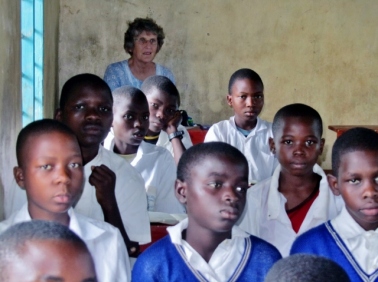 The children took off their shoes and walked through mid-calf water to get to the toilets. All good fun!)
The children took off their shoes and walked through mid-calf water to get to the toilets. All good fun!)
Our project, called the Bukoba BILL (building inclusive learning and leadership) Project, is the first of its kind. This makes us trail blazers with no prototype to follow. I love it – an empty canvas!
The only downsides being that our funding has not come through yet and we have lost Bairu, our anchor man who did all the baseline research and has a brain full of knowledge. The upside is that we have had two months to examine all the information available and do many school visits to see what is already in place. This has given us a fantastic picture of possibilities and hindrances.
The overriding thing that would improve education here is for the teachers to be at the school and in the classroom teaching. In the 12 schools we have visited I would guess that the best school had 70% of teachers teaching in the classroom while we were there. You must realize that that is a best effort put forward for the visiting foreigners. Some schools had one out of seven teachers in the classroom teaching and that only because we were the visitors. II thought the biggest problem was going to be getting the children to
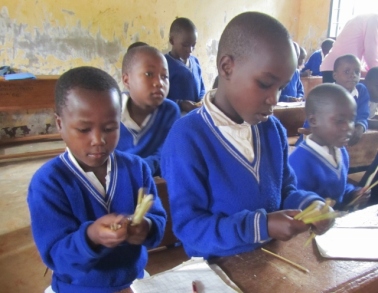
school but it is not. I’ve been thinking of what we can use as incentives to get the teachers in the classroom teaching. Louisa and Christa who come from the UK and Belgium repectively have had many parcels with felts,
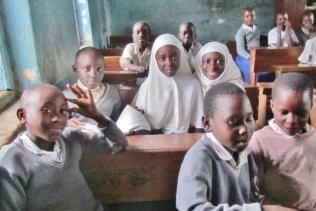 coloured pencils, stickers (simple), erasers, etc. sent by friends. The postage from there is much less than from Canada. We are going to make many packages to be given to the teacher in a school who has taught the most number of classes on their roster. Other ideas gratefully received.
coloured pencils, stickers (simple), erasers, etc. sent by friends. The postage from there is much less than from Canada. We are going to make many packages to be given to the teacher in a school who has taught the most number of classes on their roster. Other ideas gratefully received.
We have seen many brilliant lessons given by teachers who have been to workshops about using teaching aids and participatory methodology. Grade 1 math lessons with sticks for counters – a great start. However, they were doing double digit adding with carrying when the children did not yet have a concept of numbers. We have also seen the stick used frequently for discipline, tons of chalk and talk and repetition. In the 12 schools, none of us has seen a child ask a question, heard a teacher ask an open question, or seen groups with less than 8 children and one child doing all the work.
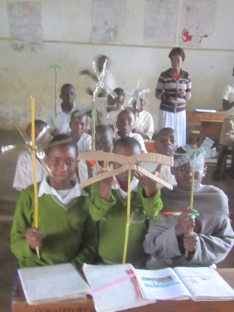 All a plus for us. It gives us direction. Our next step is to meet with the best teachers we have seen and to design together workshops in methodology that could be tried in the classrooms here.
All a plus for us. It gives us direction. Our next step is to meet with the best teachers we have seen and to design together workshops in methodology that could be tried in the classrooms here.
It summer break from now until July 15th. Our funding will be in place by then and we will be ready to move ahead quickly.
This last pictures was of windmills made by the children from plastic water bottles, sticks and a pin/nail to demonstrate how wind or water could turn a turbine. This was just as wonderful as the teachers braids, though I was unable to get a good picture of them . She is a stylie lady!
It has been so long since I wrote a blog that I can’t struggle with the formatting tonight.

Heather, your blogs are always great to read and don’t worry about the formatting! Sounds like a curriculum needs to be developed. What to teach when so it becomes developmentally age appropriate. Math is especially sequentcial and important to have the number concepts in place before going on. Would teachers attend classes if there was a packaged curriculum complete with lessons? What do they have now that tells them what to teach?